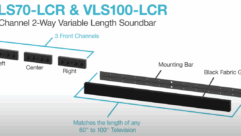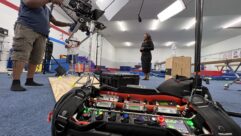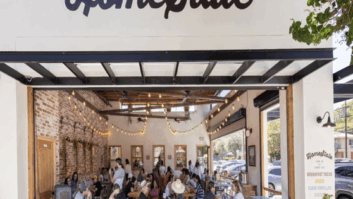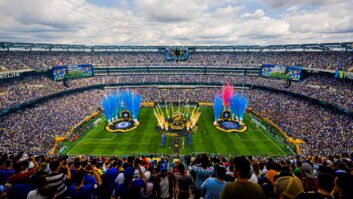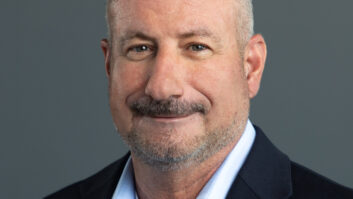On this edition of the SVC Podcast, Chris Austin, Technical Sales Manager at Autograph Sales and Installations returns to talk with Contributing Editor Bennett Liles about their work on the United Kingdom’s first Meyer Sound Lina speaker system at London’s Cadogan Hall. Chris discusses rigging the venue’s new Meyer Sound LINA speaker system, setting up the Meyer RMServer and adding Meyer’s small UP4-XP speaker enclosures.
Links of Interest:
· Autograph Sales and Installations
· Meyer Sound UP4-XP ultracompact loudspeaker
Cadogan Hall in London has an ever widening array of performers and they had to update their sound system to handle it. The project centered on a Meyer Sound LINA speaker system and a new Yamaha CL3 digital mixer. Chris Austin with Autograph Sales and Installations is back with us to finish the story on how it all got done in the middle of a very busy venue schedule. Next up on the SVC Podcast.
Chris, it’s good to have you back with us on the SVC Podcast from Autograph Sales and Installations in London. We were talking about Cadogan Hall sound system renovation with a new Yamaha CL3 and Meyer Sound’s new LINA speaker system. We went over the basics but I’d like to get a handle on the timeframe. How much time did you have to get this whole project completed? I think it was done in several stages.
Bennett, it’s lovely to be back. So the LINA part of the project was done basically all in one go. It was done over their summer shutdown period, but being such a busy venue their dark period isn’t as long as most venues. But there was enough time to get it done so we had plenty of time in advance to get exactly what we were going to do and in what order. So when we did an infrastructure upgrade in the venue a few years prior that included running some extra cables to support potential future PA changes. So we had a head start in that regard that we didn’t have to pull too much extra new cable, so we were able to find some of that to make sure that was fit for purpose before we started the installation. There was quite a bit of preliminary work that we were able to do offsite as well, for instance all the looms into the back of the line array were manufactured offsite and made off to a multi-pin so that onsite all we had to do was make off the other end. That also makes it quite easy for them to take the arrays out without having hundreds of meters of cable to manage. [Timestamp: 2:03]

Pretty smart to get as much done outside the venue as possible before you get inside and the stopwatch is running. So what was your first step after you got access to Cadogan Hall and everybody else was out of the way.
Before we turned up en masse we sent an advance party that came in to modify the rigging. Ideally I think we wanted to move the array but the rigging points, because it’s a listed building and a heritage building, there’s a restriction on how many holes you can put in the ceiling. So there were different options of which hole we could use, but after doing all the predictions we concluded that if we couldn’t bridle between two holes, which we ruled out as being aesthetically undesirable, the hanging point that we had was the best fit but didn’t quite have the right angles and needed to be rerated. So our rigging partners came in and made all those modifications before the existing array came out so when we got there the client had dropped the system for us, which was very kind, so we could get straight on with making the cabling changes and getting the new system in the air. There was a fair amount of wiring done down at stage level as well because as part of the system we put in new front fills which we kept all the cabling for hidden within the stage itself. We also changed the subwoofer configuration so there’s now flown subwoofers. There’s also subwoofers along the front of the stage. There’s a hole for them under the stage but we decided that didn’t sound the best. We also added a brand new delay position, a little fill position. So the shape of the venue means that there are some side balcony seats which sit behind the PA, so there’s a little fill in there to fill in those areas. So that needed new wiring that was all chased into the plasterwork and plastered in, so that was done in conjunction with our time onsite so that that could all be made good by the time we were gone. [Timestamp: 4:00]
Ok, were those the Meyer UP4-P speakers? The little ones?
Yeah. So the UP4-XP. They’re really nice because a lot of people are quite familiar with the MM4, the little four-inch cube. The UP4 is a more powerful version of that. It’s got a very, very nice, pleasant coverage that blends very nicely with other parts of the system so it makes a very handy front fill and a good fill anywhere because it’s very well behaved. [Timestamp: 4:29]
Let’s talk a little about how the Meyer Sound system is controlled. How does the RMServer work and what does that provide for you?
So the Meyer system, like all Meyer systems, is self-powered. The amplifier is in the back of the speakers. It’s a design decision. Some people like it, some people don’t. But one of the downsides, if there is that, is you can’t necessarily get to your amplifiers while they’re up in the air so the RMS, the remote monitoring system that Meyer provides, lets you see exactly what’s happening inside the speaker even if you can’t physically get to it. So it runs over an extra pair of conductors in the multi-core. That then runs back to a network interface box which then connects to the rest of the system over LAN so it lets you see how hard each box is working, if it’s limiting, that all the drivers are good, the amplifier is healthy. It even lets you remotely mute individual speakers, so even if you were using a looping input so you couldn’t mute them from the processor, you can actually go straight into the amplifier and mute them from there. [Timestamp: 5:35]
And what is the software app for that? What do they call it?
It used to run in its own app, but using the new RM server, which is the network server that manages it all now, you connect to it through Compass, which is the same program that you configure the speaker processes through. [Timestamp: 5:52]

Yeah, I’ve seen some videos of that and that’s a very interesting screen layout. It shows what’s going on with the sound system in a lot of detail.
Yes. It’s one of my favorites to use. It’s very, very well thought through as a work flow. Everything you need is in front of you, nothing you don’t. It’s also very, very stable so it’s a pleasure to use. Moving gain values up and down, delay values up and down with the mouse has been really well thought about so they don’t shoot off to +20 dB when you move the mouse slightly too far. No, it’s all very well put together and solid as a rock reliability-wise. [Timestamp: 6:33]
I think you’ve got four sound zones on each side of the hall. The wrap-around balcony must present a little bit of a challenge in getting the right sound in the right place.
It does. The wrap-around balcony is difficult because it wraps around so far that you get to a point where some people are just sat behind the PA, and in some cases sat behind the orchestra. So from a timing point of view that’s an impossible challenge. You can’t time align it to something that’s in the wrong direction. So the fills up there are a compromise in the way that they’re timed and set up as a compromise, but they do the job very well. We’ve actually improved the number of seats that are covered by the array over the old system so the arrays are toed out slightly more than the old system and the dispersion of the LINA allows it to hit more of the side seats. So it’s really only a corner of one seating block on each side that the fill is there to just eject a bit of HF back into and to overcome some of the timing oddities. [Timestamp: 7:37]
There are so many different types of music being performed there. How do they handle stage monitoring?
They handle stage monitoring on a gig-by-gig basis. They have a few boxes in house and I believe they rent depending on what the artists’ rider is so there’s nothing permanent because it’s so variable depending on the type of content they have. [Timestamp: 7:56]
From the pictures I’ve seen of it, the hall appears to have a lot of hard surfaces. I guess that might help the symphony performances but for other music it might go the other way.
Yes. So the ideal acoustics for a concert hall are generally at odds with the idea acoustics for a theater-type or an amplified show, but the hall has been very nicely set up so it can do both. When it was converted into a concert hall in 2004 they did an awful lot of work on the acoustics so a lot of the hard surfaces that you see are not as hard as they look. There’s a lot of absorption hidden within the walls and the ceiling, particularly at the back of the hall, to stop things bouncing around too much and they’ve put in a lot of tuned resonators in order to pit their acoustic that had been designed. So the hall sounds wonderful acoustically when you’ve got the orchestra in there. We obviously designed the line array to hit as many seats as possible but nothing more because it is still a reverberant space and you don’t want to excite that big domed ceiling, and it’s got big stained glass windows at the sides. So we’ve designed the PA to be as sympathetic to that as possible and it works. The result is very good. The sound is very intelligible. It’s very present. It’s not drowning in the reverb of the hall. [Timestamp: 9:15]

And I think that part of this project involved moving the control point in the house.
Yes. So there was a control point on the front of the balcony when it first opened, which got moved as part of the works to increase the seating capacity. So as part of that they built an extra balcony, a very shallow balcony at the very back of the hall which is where the lighting desk and the projector and some video control sits. And then an extra control position was put at the back of the stalls in a more traditional place which involved – so you take out a few seats, there’s a hidden panel in the floor that the network cables pop out of, and then you can connect the desk up and go from there. [Timestamp: 9:57]
So the Yamaha CL3 is quite a bit smaller than the M1D that you had in there before. Is that because they need to move that mixing console every now and then?
A variety of reasons. So the CL3 is considerably smaller than the PM1D it replaced yet has more capability because that’s just a huge benefit that we’re blessed with having now with all of this technology. So the fact they can do the same job or a better job with less footprint helps, but certainly the fact that the desk is so small and light means rather than them having to have a permanent control position they can pack it away. It doesn’t move into too many places. It’s either in the stalls or it’s generally packed away. What they did was they added an extra QL1 on, which is permanently connected to the Dante network, which sits up in the technical balcony so if they’re doing speech or presentation or something that doesn’t need intensive mixing they can pack the desk away completely, put the seats back and it can be mixed from up on the new technical balcony. [Timestamp: 11:00]
That’s a lot of work on this project in a very high profile place so the stakes were pretty high on it. But you got this done and it works so what’s coming up for Autograph Sales and Installations. Projects coming down the line?
We’ve got some really exciting projects on the go that are just wrapping up at the moment. But as is increasingly the way they’re all covered by various confidentiality clauses and nondisclosure agreements so we can’t name them, which is always a pity. But we hope that we’ll be able to talk about them in more detail soon. Some of them are quite groundbreaking. We’ve got a very large retail theater project on the go and some high end hospitality work, which is not new it us but it’s not the thing we’re best known for. Also we’re quite looking forward to being able to shout about those when they’re finished. [Timestamp: 11:46]
Alright, well that’ll be a change of pace and that always keeps things interesting.
Exactly.
We’ve been talking to Chris Austin, Technical Sales Manager with Autograph Sales and Installations in London. Cadogan Hall and its upgrade with Yamaha and Meyer Sound. I’ve certainly enjoyed the story on it. Amazing work when you have that much equipment and that many people and it all comes together and it works. Got to be good planning on your part.
Oh, it’s been my pleasure. We always try and get the planning right because that’s how you go and, as you say, get all those people doing the right thing in the right way. We like to think that doing a technical installation or an integration project is not that different from putting on a show. There’s lots of different people all trying to achieve the same goal. If you can all pull together and realize that you’re not competing with each other you’re all trying to get a good result, you can get it done early and the client is always very happy. [Timestamp: 12:38]
Getting all of it in the right order so all the dominos fall the right way. Thanks for the details on it, Chris.
Thank you very much for inviting me on. It’s been great.
Autograph Sales and Installations has put Cadogan Hall back on the top of its game with new gear from Meyer Sound and Yamaha. Now, the tech crew there can handle anything and invite a bigger audience. Get with us next week to hear about another AV installation project on the SVC Podcast.





